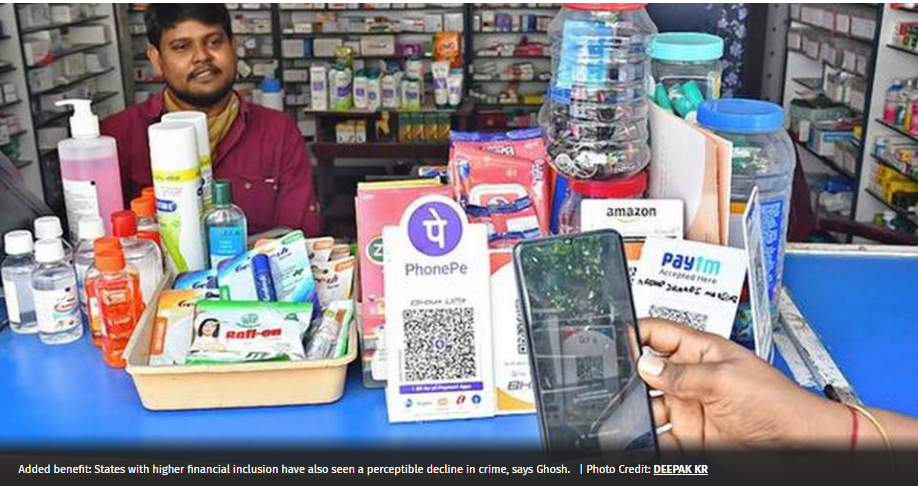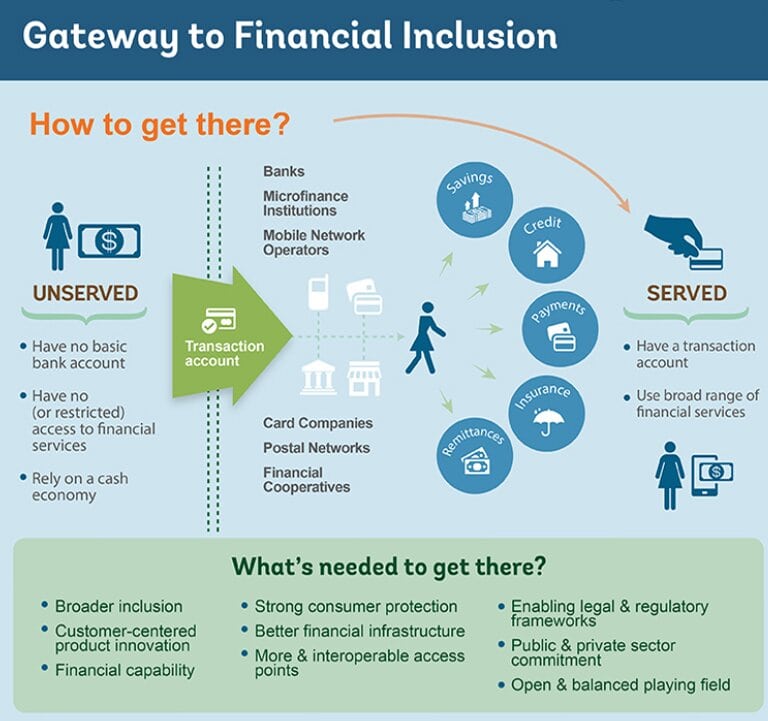Description

Figure 1: No Copyright Infringement Intended
Context:
- According to SBI research report, India is now ahead of China in financial inclusion metrics.
Details of the Report:
- States with higher financial inclusion / more bank accounts have also seen a perceptible decline in crime along with a meaningful drop in consumption of alcohol and tobaccos.
- The number of no-frills bank accounts opened has reached 43.7 crore with ₹1.46 lakh crore in deposits as of October 20, 2021.
- Of these, almost two-thirds are operational in rural and semi-urban areas and more than 78% of these accounts are with state-owned banks, 18.2% with regional rural banks, and 3% are opened by private sector banks.
- The number of banking outlets in villages / BCs had risen from 34,174 in March 2010 to 12.4 lakh in December 2020.
About Financial Inclusion:
Financial Inclusion, broadly defined, refers to universal access to a wide range of financial services at a reasonable cost. These include not only banking products but also other financial services such as insurance and equity products.

Need for Financial Inclusion:
- Financial inclusion broadens the resource base of the financial system by developing a culture of savings among large segment of rural population and plays its own role in the process of economic development.
- Further, by bringing low income groups within the perimeter of formal banking sector; financial inclusion protects their financial wealth and other resources in exigent circumstances.
- Financial inclusion also mitigates the exploitation of vulnerable sections by the usurious money lenders by facilitating easy access to formal credit.
Objectives for Financial Inclusion:
RBI identified six strategic objectives of a national strategy for financial inclusion:
- universal access to financial services,
- providing basic bouquet of financial services,
- access to livelihood and skill development,
- financial literacy and education,
- customer protection and grievance redressal,
- effective coordination.
Milestones for Financial Inclusion:
- providing banking access to every village (or hamlet of 500 households in hilly areas) within a five km radius by March 2020,
- strengthening digital financial services to create infrastructure to move towards a cash less society by March 2022,
- Ensuring that every adult has access to a financial service provider through a mobile device by March 2024.
Measurement of Financial Inclusion:
- measure access, such as number of bank branches or ATMs for a specified population,
- measure usage, such as percentage of adults with a saving account, insurance or pension policy,
- measure quality of services, such as grievance redressal (through number of complaints received and addressed).
Challenges with Financial Inclusion:
- Financial literacy: India is home to 17.5 per cent of the world’s population but nearly 76 per cent of its adult population does not understand basic financial concepts.
- Insurance policy issues: On account of lack of awareness and failure of institutions to guide them, people buy insurance policies without planning and give up midway because they don’t have money to pay premium.
- Access to Credit: But despite the strong growth, only 200 million borrowers have had access to credit from formal channels. This is the reason why the credit penetration index of CRISIL Inclusix remained low. There is also a large degree of self-exclusion due to the existence of informal credit sources meeting their convenience.
- Digital Connectivity issues: - When most of the rural areas still not having even a reliable internet facility it is difficult to push for a cashless economy.
- From the demand side, the reasons are low income, poverty and illiteracy and lack of awareness.
- From the supply side branch proximity, timings, cumbersome documentation and procedures,
attitude of the bank staff and language.
- Remoteness from the financial institutions: Usually, banks are locating their branches in the high densely populated areas for covering its cost of operations. Low penetration of financial services, less efficiency of business correspondents also limits the success of financial inclusion.
Government Schemes:
- Pradhan Mantri Jan Dhan Yojana (PMJDY), under which 34 crore accounts have been opened with deposits amounting to Rs 89,257 crore (as of January 2019).
- Pradhan Mantri Suraksha Bima Yojana to provide accidental death or disability cover and Atal Pension Yojana to provide pension cover to subscribing bank account holders.
- bank-led model of financial inclusion adopted by the RBI through issuance of differentiated banking licenses (small finance banks and payments banks) and the launch of Indian Post Payments Bank in September 2018 has helped bridge the gap in last mile connectivity.
Way Forward:
- Reviving Banking Correspondent Model: Given the infeasibility of locating branches in every nook and corner of the country, bank correspondents are used to reach out to prospective clients. However, an inadequate compensation structure makes correspondent banking unattractive.
- Leveraging JAM Trinity: Technology should be used to improve the assessment of credit-worthiness for households and informal businesses. With the adoption of appropriate technology a new data-sharing framework (using Jan Dhan and Aadhaar platforms), to enable easier access to credit, with adequate safeguards for maintaining data privacy.
- Need For Data Protection Regime: In addition to greater digitization, there is also a need to strengthen cyber security and data protection regime in the country.
- Leveraging Differentiated Banks: Differentiated Banks like Payment banks and small finance banks can be leveraged to scale up payments systems in underserved areas.
- Promoting USSD for Rural Areas: Payments through the USSD channel should be promoted (by reimbursing the charges incurred in the USSD process), as they have an advantage over the internet in that it can also cover a large proportion of non-smartphone users.













